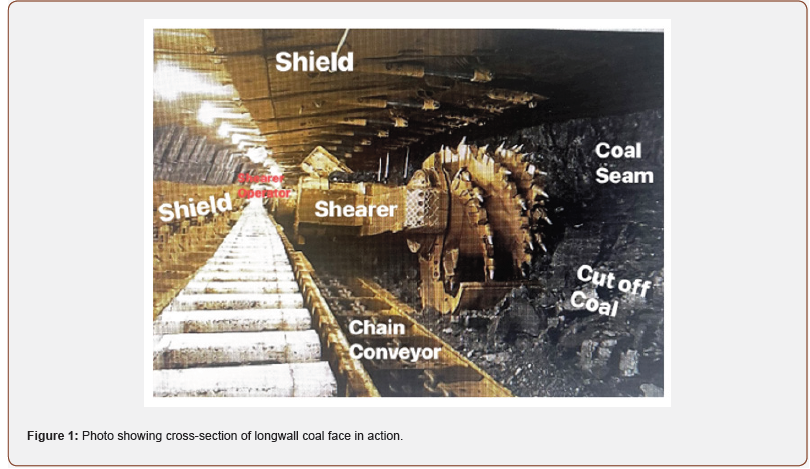 Mini Review
Mini Review
Major Issues Related to Underground Longwall Coal Mining Automation
Syd S. Peng1,2*, WB Guo2 and F Du2
1West Virginia University, Morgantown WV, USA
2Henan Polytechnic University, Jiaozuo, Henan, China
Syd S Peng, West Virginia University, Morgantown WV, USA
Received Date:December 22, 2023; Published Date:January 09, 2024
Abstract
Mining is the oldest industry. It has many unknown factors. That’s why its technology advancement is so slow. This is especially true for the case of underground longwall coal mining. Longwall coal mining employs three type of machines (shearer, shield, and chain conveyor) interconnected to cut coal from in-situ coal seams continuously, i.e., coal cut off by the shearer is dumped on the chain conveyor that carries the cut-off coal pieces to surface via underground belt conveyor system (see figure below). (Figure 1)

Introduction
Longwall coal mining is among the pioneer industries that adopted digital technology when personal computers were first developed in the early 1980s. In fact, longwall shields equipped with computers were first installed in a mine in northern West Virginia in 1984 and its automatic operation soon became very reliable in routine safe production operation. Unfortunately, it was not so lucky about the shearer’s automation. The shearer has two cutting drums operated by two operators, one on each end. The leading operator is to steer the leading drum to cut at the interface of coal seam and roof strata, while the trailing operator is to steer the trailing drum to cut at the interface of coal seam and floor strata. Such that one shearer’s passage will cut out the whole coal seam from the immediate roof to the immediate floor strata without the dilution of roof and floor rocks. Therefore, for shearer’s automation, the shearer will need to adjust itself to follow the contact line of roof strata and coal seam for the leading drum and that of coal seam and floor strata, respectively. If the drums cut the roof or floor rocks, it may generate sparks that ignite methane gas catching fire or methane explosion.
The coal seam, or the entire series of strata above and below it, varies in thickness and physical characteristics, both horizontally and vertically, within various distances. In other words, the 3D geological configuration, especially the coal seam is very difficult to predict. The shearer operator steers the cutting drum by using his/her seeing, hearing, and sensing ability. It follows that to be automated, a shearer must have the same seeing, hearing, and sensing ability just like the human operator does. Sensors have been developed to equip the shearer with those capability. Since the early 1990s, various types of sensors including gamma rays, bit vibration, difference in hardness between coal and rocks, etc. have been used without success. The current most advanced system is to use gyro, plus heat sensing to determine the shearer’s attitude (instantaneous inclination of shearer’s body along and perpendicular to the shearer advancing direction, thereby drum’s elevation), instantaneous location, travel direction and speed, and cutting horizon. However, due to the ever-changing geological condition, or unpredictable seam undulation, production scale automation has not been attainable.
It follows that precise geology mapping of all strata, especially coal seam and immediate roof and floor is the prerequisite for shearer, and therefore longwall, automation. So far there is no reliable coal seam model for this purpose. Another problem is shortage of effective sensors. Sensors of various types are needed to replace operator’s commands generated from seeing, hearing and sensing reactions. In addition to high sensitivity, it must be able to operate reliably in extreme environmental conditions continuously, because underground coal mines are full of dust, highly humid with water mist cloud, plus some hazardous gases.
Among the three machines, collision between shield and shearer is another hazard due to the changing attitude of shield as it advances from cut to cut and the high travel speed of the shearer, up to 140 ft/min, mostly 50-60 ft/min. In summary, among the three machines, chain conveyor and shield move linearly that is easier to automate and have done so. It is the shearer’s automation that still requires basic development. The goal is to cut coal clean within the coal seam without cutting into roof and floor rocks. The problem is seaming thickness varies constantly, causing the shearer to travel along undulated track.
Acknowledgement
None.
Conflict of Interest
No conflict of interest.
-
Syd S. Peng*, WB Guo and F Du. Major Issues Related to Underground Longwall Coal Mining Automation. On Journ of Robotics & Autom. 2(3): 2024. OJRAT.MS.ID.000538.
Shearer, Shield, Chain Conveyor, Mining, Shearer’s Automation, Geological Configuration, coal seam, Gamma rays, Production scale
-

This work is licensed under a Creative Commons Attribution-NonCommercial 4.0 International License.






